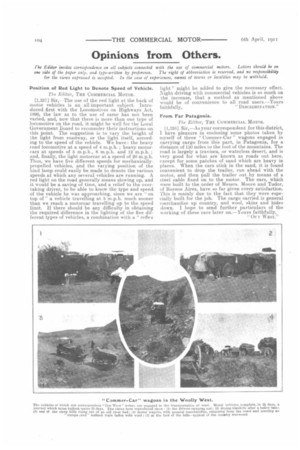Opinions from Others.
Page 16

If you've noticed an error in this article please click here to report it so we can fix it.
The Editor invites correspondence on all subjects connected with the use of commercial motors. Letters should be an one side of the Paper only, and type-written by preference. The right of abbreviation is reserved, and no responsibility for the views expressed is accepted. In the case of experiences, names of towns or localities may be withheld.
Position of Red Light to Denote Speed of Vehicle. The Editor, THE COMMERCIAL MOTOR.
[1,337] Sir,The use of the red light at the back of motor vehicles is an all-important subject. Introduced first with the Locomotives on Highways Act, 1696, the law as to the use of same has not been varied, and, now that there is more than one type of locomotive on the road, it might be well for the Local Government Board to reconsider their instructions on this point. The suggestion is to vary the height of the light from roadway, or the light itself, according to the speed of the vehicle. We have : the heavy road locomotive at a speed of 4 m.p.h. ; heavy motor cars at speeds of 5 m.p.h., 8 m.p.h. and 12 ; and, finally, the light motorcar at a speed of 20 m.p.h. Thus, we have five different speeds for mechanicallypropelled vehicles, and the varying position of the hind lamp could easily be made to denote the various speeds at which any several vehicles are running. A red light on the road generally means slowing up, and it would be a saving of time, and a relief to the overtaking driver, to be able to know the type and speed of the vehicle he was approaching, since we are "on top of" a vehicle travelling at 5 m.p.h. much sooner than we reach a motorcar travelling up to the speed limit. If there should be any difficulty in obtaining the required difference in the lighting of time five different types of vehicles, a combination with a " reflex light" might be added to give the necessary effect. Night driving with commercial vehicles is so much on the increase, that a method as mentioned above would be of convenience to all road users.—Yours faithfully, " DISCRIMINATION."
From Far Patagonia.
The Editor, THE COMMERCIAL MOTOR.
Sir,—As your correspondent for this district, I have pleasure in enclosing some photos taken by myself of three " Commer-Car " wagons engaged in carrying cargo from this part, in Patagonia, for a distance of 150 miles to the foot of the mountains. The road is largely a traviserv, or waterless desert, and is very good for what are known as roads out here, except for some patches of sand which are heavy in places. When the cars stick in the sand, it is found convenient to drop the trailer, run ahead with the motor, and then pull the trailer out by means of a steel cable fixed on to the motor. The cars, which were built to the order of Messrs. Moore and Tudor, of Buenos Aires, have so far given every satisfaction. This is mainly due to the fact that they were especially built for the job. The cargo carried is general merchandise up country, and wool, skins and hides down. I hope to send further particulars of the working of these ears later on.—Yours faithfully, " Our WEST."




















